
Ichthyology is the branch of zoology devoted to the study of fish, including bony fish (Osteichthyes), cartilaginous fish (Chondrichthyes), and jawless fish (Agnatha). According to FishBase, 33,400 species of fish had been described as of October 2016, with approximately 250 new species described each year.

Sparidae is a family of ray-finned fishes belonging to the order Spariformes, the seabreams and porgies, although they were traditionally classified in the order Perciformes. They are found in shallow temperate and tropical waters around the world and are demersal carnivores.

Threadfins are silvery grey perciform fish of the family Polynemidae. Found in tropical to subtropical waters throughout the world, the threadfin family contains eight genera and about 40 species. An unrelated species sometimes known by the name threadfin, Alectis indicus, is properly the Indian threadfish.
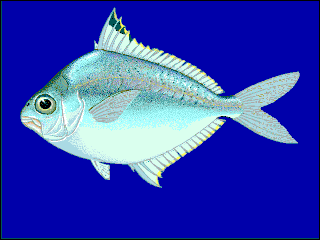
Leiognathidae, the ponyfishes, slipmouths or slimys / slimies, are a small family of fishes in the order Perciformes. They inhabit marine and brackish waters in the Indian and West Pacific Oceans. They can be used in the preparation of bagoong.

Labeo is a genus of carps in the family Cyprinidae. They are found in freshwater habitats in the tropics and subtropics of Africa and Asia.

Thryssa is a genus of anchovies in the family Engraulidae. Some authorities include the species from the genus Thrissina here.

Halichoeres are a genus of wrasses found in the Atlantic, Indian and Pacific Oceans.

Polydactylus is a genus of threadfin that mainly are native to the Indian, Atlantic and Pacific Oceans, especially in coastal or brackish waters. Some may even enter rivers and a single, P. macrophthalmus, is a freshwater fish from rivers in Borneo.
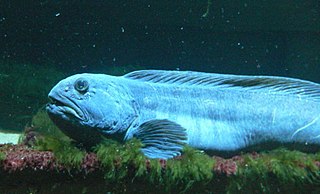
Zoarcoidei is a suborder of marine ray-finned fishes belonging to the order Perciformes. The suborder includes the wolffishes, gunnels and eelpouts. The suborder includes about 400 species. These fishes predominantly found in the boreal seas of the northern hemisphere but they have colonised the southern hemisphere.
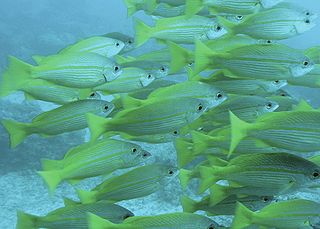
Lutjanus is a genus of marine ray-finned fish, snappers belonging to the family Lutjanidae. They are found in the Atlantic, Indian, and Pacific Oceans. They are predatory fish usually found in tropical and subtropical reefs, and mangrove forests. This genus also includes two species that only occur in fresh and brackish waters.

Decapterus is a genus of marine fishes of jack family, Carangidae, commonly known as mackerel scads, round scads, or horse mackerel. They are found throughout the world.
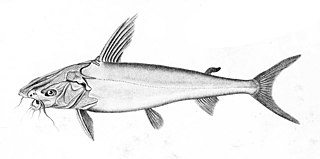
Netuma is a genus of sea catfishes found in the Indian Ocean and the western Pacific Ocean where it occurs in marine, brackish and fresh waters from the coasts of Africa to Australia to China. There are currently four recognized species in this genus.

Deveximentum is a genus of ponyfishes native to the Indian Ocean and the western Pacific Ocean.

Gerres is a genus of mojarras found mostly in coastal regions from the eastern Atlantic Ocean through the Indian Ocean to the western Pacific. A single species, G. simillimus, is from the East Pacific. They mainly inhabit salt and brackish waters, but will enter fresh water. At least one species, Gerres cinereus, displays an ability akin to gyroscopic stability, allowing it to remain in a remarkably static spatial position relative to the water flowing around it.

Pomadasys is a genus of grunts native to the waters of the eastern Atlantic Ocean and through the Indian Ocean to the Pacific coast of the Americas. The name of this genus is a compound of poma meaning "lid" or "covering" and dasys meaning "rough", a reference to the serrated preopercle.

Equulites is a genus of ponyfishes native to the Indian Ocean and the western Pacific Ocean. Analysis of mitochondrial DNA published in 2017 has suggested that Equulites elongates is in fact a species group made up of three species Equulites aethopos, Equulites elongates and Equulites popei.

Nuchequula is a genus of ponyfishes native to the Indian Ocean and the western Pacific Ocean.

Photopectoralis is a genus of marine ray-finned fishes, ponyfish from the family Leiognathidae. They are native to the Indian Ocean and the western Pacific Ocean.
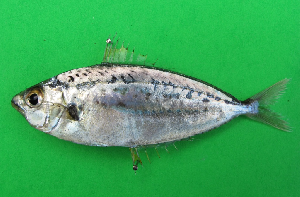
Equulites popei, Pope's ponyfish, is a species of marine ray-finned fish, a ponyfish from the family Leiognathidae. It has a wide Indo-Pacific distribution which extends from the Red Sea east to the western Pacific Ocean. It has entered the Mediterranean as a Lessepsian migrant. It was formerly considered to be synonymous with the elongate ponyfish.
Doboatherina is a genus of fish in the family Atherinidae .There are found in the tropical habitats of Indian and Pacific ocean. It contains eight species:




















